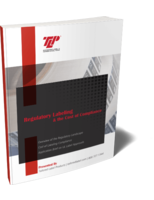60,000 Machines Later, Lantech Marks 35 Years Since Company Developed First Commercially Successful Pallet Stretch Wrapper
1972 invention made unitizing practical, affordable and safe for almost any product. Approximately 3 billion pallets wrapped annually with the technology.
Louisville, KY, July 2007 - 1973 was a year that changed the trucking and packaging industries forever, with Lantech's introduction of the first commercially successful pallet stretch-wrapping machine at the American Packaging Industry Association Show (now Pack Expo). Conceived in 1972, the new machine made unitizing practical, affordable and safe for almost any product. It allowed bags, buckets, boxes, building materials, etc., to be secured on a pallet for truck shipment, instead of floor-stacked, strapped to a pallet, or shrink-bagged on a pallet. Based on the one billion pounds of stretch wrap produced worldwide every year, Lantech estimates that nearly 3 billion loads per year are currently shipped using this technology.
Today, Lantech leads the industry with the dominant market share, 175 U.S. and foreign patents, more than 400 employees and continuing independent ownership under CEO Jim Lancaster, son of founder Pat Lancaster, who serves as Chairman and product development consultant to the company. In the tradition of 1973, Lantech amazed Pack Expo attendees again last November when it introduced the fastest stretch wrapping system in the world, capable of wrapping three pallets per minute with spider-like speed. The company will, again, be a major exhibitor this year at Pack Expo Las Vegas, October 15-17, showing all of its product lines in stretch wrapping, shrink packaging and case erecting.
From zero to 3 billion loads per year in 35 years
Brothers Pat and Bill Lancaster founded Lantech in 1972 to help develop and market an infrared system for shrinking the plastic bags used for some pallet loads at the time. Both were familiar with packaging technology and plastic films by virtue of their father's business, Superior Paper Company in Louisville.
Realizing the limitations of shrink bags for pallet unitizing - cost, energy waste, and heating of the load - the two brothers tested ideas for using plastic film to get the containment benefits of shrink bags, without the heat and energy use. They improvised with various films for dry cleaning, meat and poultry packaging.
Conceptually based on stretching a rubber band around a pallet load, their prototype stretch wrapping machines used a brake made for a Ford Falcon and a shock absorber for Harley-Davidson motorcycles because neither of the inventors was yet accustomed to specifying industrial mechanical components.
When the brothers introduced their first production machine at the packaging show in May 1973, it proved a "wildly successful idea," according to company CEO Jim Lancaster. It cut the cost to unitize a pallet to just 75¢-$1.00, compared to $2.00-5.00 for strapping (depending on use of a top frame) or $1.35-$1.40 for shrink bags. It eliminated most of the labor and all the hazards of working with steel strapping, as well as the equipment cost, energy cost, and potential for product damage involved with heating shrink bags.
The 1973 packaging show launched Lantech into more than a decade of growth, with production rising from four machines the first year to a one per day by 1977. 1973 was also the start of massive oil price increases and an Arab oil embargo. This spurred demand for the company throughout the decade because stretch wrapping reduced plastic film use and required no heating.
Resource conservation continues to be a prime driver in stretch wrapping technology, along with speed and labor reduction. Unitizing with shrink bags in the sixties required about two pounds of plastic film per pallet. The first stretch machines used a little over a pound of film per load and the wrapping cycle took about two minutes with manual labor involved. Lantech's newest Ring-Straddle(TM) machine is unitizing paper products with three and one-half ounces of film per load, and beverages with just four and one-half ounces, at speeds of 20 seconds with no labor.
Among its many innovations, Lantech was first to automate stretch wrapping so it could be integrated with a palletizer; first with a horizontal stretch wrapper for non-palletized products that will not fit on a turntable stretch wrapper, such as windows, doors, fence and pipe; and first with a pre-stretch system that reduced film use by another 50%.
"Our product development focus has always been aimed at improving the customer's uptime, labor utilization and material reduction," said Jim Lancaster. "We have people in customer plants every day of the week, studying their operations in depth to help us stay ahead of changing trends, and help our customers increase productivity."
Lantech stresses productivity improvement in its own operations as well. It was the first packaging machinery producer to institute "lean manufacturing" in its operations. As one of the first non-automotive companies in the U.S. to adopt practices of the Toyota Development System in 1992, Lantech's success was featured in INC. Technology magazine in 1996.
Lantech currently employs more than 400 people in North America, Europe and Asia, with its main plant in Louisville encompassing 200,000 sq. ft., including the largest R&D facility in the industry. It has aggressively pursued "lean" strategies at every level to deliver industry-leading products and services on a cost-competitive basis, earning it "preferred" status with most Fortune 500 companies.
Under Jim Lancaster's management, Lantech has made strategic and complementary additions to its product technologies, and broadened it global footprint for sales and sourcing. It has established a manufacturing and engineering presence in Europe, introduced a line of case erectors and case packers, and developed a line of patented shrink packaging systems - all since 2003. "We continue to pursue initiatives that will expand our core technologies and global exposure," Lancaster added. "Our goal is to complete what started in 1972, by becoming the dominant global brand in secondary packaging machinery."




